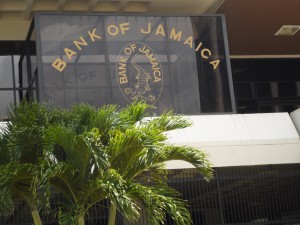The latest Treasury bills issued by the Government of Jamaica saw a big jump in interest rates on two instruments, with the 91 day T-bill jumping by 57 percent compared to the rate in March, at the same time, the 182 days instrument rose by 36 percent.
 The April auction attracted total bids of $3.6 billion for the $2.2 billion offered for three different maturity dates.
The April auction attracted total bids of $3.6 billion for the $2.2 billion offered for three different maturity dates.
The T-bills for the 91 days ended with an average yield of just under 1.94 percent, up nearly 57 percent from 1.235 percent at the March 12 auction. The 182 days note jumped 36 percent to just under 2.071 percent and the 273 days note ended at 2.469 percent for the $800 million on offer.
The March auction had just two issues amounting to $1.4 billion, but it attracted $7.4 billion in bids while the February issues pulled in $6 billion for the $2.2 billion offered in three issues, resulting in the average yields were slightly below the latest issues in April. The rates for February ended at 1.52831 percent, 1.96323 percent and 2.41164 percent, respectively.
57% jump in T-bill rates
T-Bill plunged to lowest rates on record
In the latest Government of Jamaica Treasury bill (T-bill) auction, for April, rates hit their lowest level on record. The fall reversed the sharp uptick in rates at the March auction, with the average rate for the half-year instrument then hitting 2.01 percent and the three months 1.87 percent.
 At the April auction, T-bill rates dropped to 1.08 percent for the 91 days Treasury bills, while the 182 days instrument ended with an average of just 1.05 percent. The rate for the 273 days instrument, averaged 1.73 percent.
At the April auction, T-bill rates dropped to 1.08 percent for the 91 days Treasury bills, while the 182 days instrument ended with an average of just 1.05 percent. The rate for the 273 days instrument, averaged 1.73 percent.
In March, the demand dropped sharply to just $1.05 billion, for the half T-bills, the amounts applied for falling from $2.32 billion to $1.41 billion, in April, $2.46 billion chased after the $700 million on offer for the 90 days instrument, $2 billion went after the 181 days note and $1.5 billion chased down the 270 days bills. In each case, the GOJ offered $700 million to the public.
April T-Bill cacelled as GOJ cash surges
 Regular issue of Treasury bills would normally be held by the 19th of April but none were offered this time around based on the absence of an announcement by the Central Bank of Jamaica.
Regular issue of Treasury bills would normally be held by the 19th of April but none were offered this time around based on the absence of an announcement by the Central Bank of Jamaica.
When the last issue of Treasury bill closed on Friday, 15 March 2017, the Bank of Jamaica stated that applications for the next offer of Government of Jamaica Treasury Bills must be lodged at the Bank of Jamaica by 10:45 a.m. on Wednesday, 19 April 2017. Bank of Jamaica acting on behalf of the government would make an announcement of the date and amounts for the upcoming issue. The website of Bank of Jamaica carries information when the public is being offered news bills and the result of the issue, a check on the site throws no information on the April issue, with no announcement no explanation for cancelation of the issue.
At the end of February, data out of the Ministry of Finance showed a budgetary surplus of $17.5 billion in revenues above forecast and a cash deficit of $5.5 billion. With March projected to generate large net inflows of revenues over outflows, the central government would not need to borrow from the financial market. Inflows was projected at $72 billion and expenditure at $35 billion for March, if achieved would result in a surplus of $30 billion for the financial year.
 During 2016 inflation was negatively affected b a 7 percent decline in the value of the Jamaican dollar against the United States currency, that would have contributed to most of the inflation except the portion relating to increased taxes, imposed last year. Devaluation if any, should be more moderate in 2017, as foreign exchange flows continue to be strong, therefore inflation should moderate with the absence of devaluation of the local dollar.
During 2016 inflation was negatively affected b a 7 percent decline in the value of the Jamaican dollar against the United States currency, that would have contributed to most of the inflation except the portion relating to increased taxes, imposed last year. Devaluation if any, should be more moderate in 2017, as foreign exchange flows continue to be strong, therefore inflation should moderate with the absence of devaluation of the local dollar.





